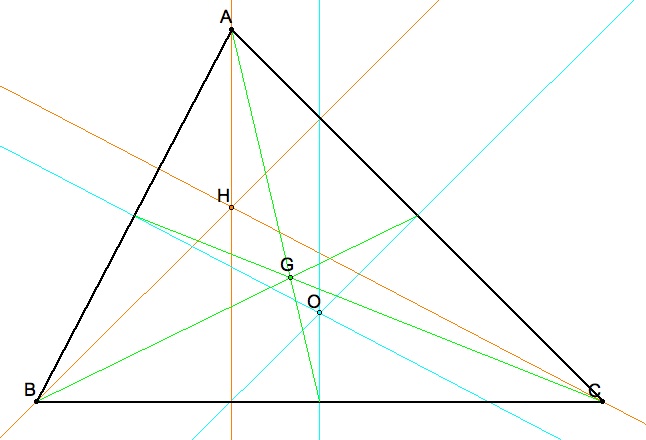
Assignment 4
The Euler Line
by Emily Bradley
In a triangle ABC, let O be the circumcenter, let G be the centroid, and let H be the orthocenter.
Then O, G, H lie on a line (called the Euler line of the triangle) and GH ≅2OG.
Definitions:
Circumcenter- the point in the plane equidistant from the three vertices. This point is on the perpendicular bisectors of each side of the triangle.
Centroid- the common intersection of the three medians.
Median- the segment from a vertex to the midpoint of the opposite side.
Orthocenter- the common intersection of the three lines containing the altitudes.
Altitude- a perpendicular segment from vertex to the line of the opposite side.
Proof
| Given | Triangle ABC with circumcenter O, centroid G, and orthocenter H.
|
| Proof | Let D be the midpoint of BC. Then AD is a median. Let E be the point formed by the altitude AE. Let the line OG meet the altitude AE at a point H'. Want to show that H' = H, therefore O,G, and H are colinear. Note that OD is perpendicular to BC, and AE is perpendicular to BC. Hence OD is parallel to AE.
|
Therefore, ∠GAH' ≅ ∠GDO, since they are alternate angles. Also, ∠AGH' ≅ ∠DGO, since they are vertical angles. Because the centroid G lies on each median 2/3 of the way from the vertex to the opposite side's midpoint, AG is 2/3 of AD and GD is 1/3 of AD. Hence AG ≅ 2GD. Thus we can apply (2ASA), and ΔAGH' ≅ 2ΔFGO. Therefore all sides in ΔAGH' are twice the length of sides in ΔFGO.
|
|
| Thus the point H' is the point on the ray OG such that GH' = 2OG. It follows that H' also lies on the other altitudes of ΔABC, so H' = H, the orthocenter. We conclude that O, G, H are collinear and GH ≅ 2OG. |
Student Activity
The following activity provides student with the chance to prove this for themselves tangibly with a triangle that they construct.
In a triangle ABC, let O be the circumcenter, let G be the centroid, and let H be the orthocenter.
Then O, G, H lie on a line (called the Euler line of the triangle) and GH ≅2OG.
Create a large triangle out of an 8.5x11. For the purpose of this exercise the triangle needs to be acute scalene. (Acute for us to be able to mark O,G, H on our triangle and Scalene so that none of these points coincide with each other) I am using the same triangle as in the first proof to facilitate comparison.
|
Begin by finding the circumcenter, the point in the plane equidistant from the three vertices. This point is on the perpendicular bisectors of each side of the triangle. To find the perpendiclar bisector for one side, start by finding the midpoint of it. You can do this by having corner meet corner. This also keeps the edge lined up on both sides of the fold. Doing so ensures the fold is perpendicular.
|
Do this for each side of the triangle. Do your lines intersect at one point? They should! The intersection of these points is your circumcenter. Label this point O.
|
To find the centroid, you need to find where the medians intersect. A median is the segment from a vertex to the midpoint of the opposite side. You have already found the midpoint. Create a fold that goes through this point and the opposite vertex.
|
Do this for each side. Do all three lines intersect? The intersection is then called the centroid. Label this point G.
|
To find the orthocenter find the common intersection of the altitudes. An altitude is a perpendicular segment from vertex to the line of the opposite side. To do this start with the vertex and adjust the fold so that the bottom edge lines up with itself, keeping the vertex as the other point.
|
Do this for all three sides. Those lines should all meet again at one point. This intersection is called the orthocenter. Label this point H.
|
Look at points O, G, and H. Do they look as though they lie in a straight line? Draw this line in. Measure each segment and fill in the following (include units). Length of HO_______________ Length of HG_______________ Length of GO_______________
|
Questions: 1. Was our conclusion met? "O, G, H lie on a line (called the Euler line) and GH ≅2OG"
2. Could you have only folded two lines to find O instead of three. Why is that? True for G? H?
3. Why does keeping the edge flat with itself in a fold ensure the fold will be perpendicular?
4. What do you notice about the measurement of HG to HO? Why is that?
5. What is the relationship between OG and OH? Why?
|
Answers: 1. YES 2. Yes because the intersection of two lines would b e the same as the intersection of the three lines. 3. A straight line is 180 degrees or two right angles. Dividing this into two equal parts, each part is a right angle. This isthe definition of a perpendicular. 4. 2/3. 1:2, whole = 3. 5. 1/3. 1:2, whole = 3. |










